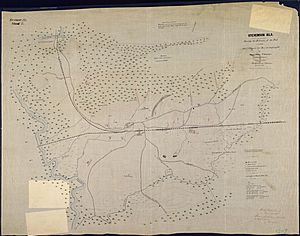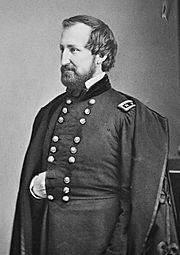Fort Harker (Alabama) facts for kids
Quick facts for kids |
|
|
Fort Harker
|
|

Fort Harker Artillery
|
|
| Location | South of AL 117 |
|---|---|
| Nearest city | Stevenson, Alabama |
| Built | 1862 |
| NRHP reference No. | 77000205 |
| Added to NRHP | May 2, 1977 |
Fort Harker, located near Stevenson, Alabama, was a military fort built by the Union Army during the American Civil War. It was constructed in the summer of 1862 by soldiers and freed slaves from the Army of the Cumberland. This fort helped protect important railroad lines. These lines were key for moving Union troops and supplies in southeastern Tennessee and northeastern Alabama. Union General William Rosecrans set up his main office at Fort Harker in July 1863. From there, he led a successful plan against Confederate General Braxton Bragg in Chattanooga, Tennessee. After the war, the fort was left empty and fell apart. However, it was later fixed up and became a city park in 1985.
Contents
A Fort for Protection
Fort Harker was built to defend a very important area that Union troops had taken over in northeastern Alabama. It was placed on a hill east of the town of Stevenson. Soldiers and freed slaves from the Army of the Cumberland built it in the summer of 1862. This army was led by Union General William Rosecrans.
Stevenson was a key spot because it was where two major railroads met: the Memphis and Charleston Railroad and the Nashville and Chattanooga Railroad. The fort was built so it could fire on the town, the railroads, and the supply areas. Besides Fort Harker, the Union Army also built a hospital and a refugee camp in Stevenson. The Union's control of this area stopped Confederate troops from using the railroads to defend Chattanooga. It also kept important supply lines open for the Union Army.
How the Fort Was Built
The design of Fort Harker was common for forts built during the American Civil War. It was a square-shaped earthen fort, about 45 meters (148 feet) on each side. The walls were made of packed earth, about 4.3 meters (14 feet) high. A dry ditch, or moat, about 2.5 meters (8.2 feet) deep, surrounded the walls.
The fort had seven platforms, called barbettes, for large cannons. It also had a bomb-proof powder magazine, which was a safe place to store gunpowder. To get into the fort, people used a drawbridge over the moat. In the middle of the fort was an eight-sided wooden blockhouse.
Important Battles and Commanders
General Rosecrans made Fort Harker his main office in July 1863. From here, he planned a successful attack against Confederate General Braxton Bragg and his Army of Tennessee in Chattanooga, Tennessee. After the Union won this battle, Rosecrans did not chase the enemy very quickly. Bragg and his troops were able to retreat in an orderly way into Georgia.
Rosecrans and Bragg met again in Georgia at the Battle of Chickamauga. The Union army was badly beaten and almost completely defeated. This forced Rosecrans and his men to go back to Chattanooga. Confederate troops then surrounded Chattanooga. Because of this, General Ulysses S. Grant removed Rosecrans from his command. Grant put General George H. Thomas in charge instead.
The Battle of Chattanooga began on November 24, 1863. The Union won this battle. This victory made sure that southeastern Tennessee and northeastern Alabama, including Fort Harker, stayed under Union control for the rest of the war.
After the War
Fort Harker was left empty when the American Civil War ended. It started to fall apart. Local people used the land for farming, including gardens and raising hogs.
Work to dig up the site and preserve its history began in 1976. Restoring the fort so the public could visit started in 1985. Repairs were needed because mountain bike riders had damaged the fort. Also, the Stevenson Police Department had used the fort walls for target practice.
Visiting Fort Harker
Fort Harker is now a city park in Stevenson, Alabama. Besides the historic fort, there is a wildlife observation platform. This platform offers nice views of nearby Crow Creek. The fort is listed on the National Register of Historic Places. This means it is an important historical site. The Alabama Historical Commission has also placed a historical marker at the fort.
Gallery








